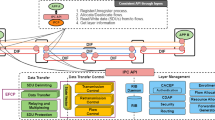Abstract
We illustrate the role of service management in managing the quality-of-service (QoS) of applications. An increasing diversity of applications is expected to be offered over future networks. Even if these applications use the same “media”, their connection-level QoS measures can be different depending on their connection-level resource requirements and on their implementation at the connection layer. To illustrate this, we consider two representative service classes. Simple applications refer to applications that involve a fixed number of clients and point-to-point connections. Complex applications, on the other hand, are characterized by dynamic client-membership and require multipoint connections. These two service classes perceive different connection-level QoS measures. For instance, simple applications can get blocked-external blocking is a possible QoS measure. Complex applications can, in addition to external blocking, suffer from internal loss. The latter is defined as the probability that a client in an ongoing application aborts the application because a newer client cannot add to the application. Internal loss is a measure of how clients in a complex application (such as a conference) are bound to each other at the application layer. Thus, the QoS of complex applications is then expressed as a tuple of external blocking and internal loss probabilities. In this paper, we consider an end-to-end ATM platform and assume that the traditional ATM admission problem has been solved. The service manager manages the connection-level QoS of these two service classes by an overlay—that is, it overlays ATM connection admission procedures. Its objective, from a fairness viewpoint, is to ensure that the QoS perceived by an application is independent of its service class. We study a service management implementation that uses a threshold to allocate available bandwidth to simple applications and to complex applications. We compute exactly, through queueing analysis, the QoS measures of the two service classes as a function of the threshold. We propose an optimality criterion for the threshold whereby both service classes suffer equal degradation. An interative algorithm uses this criterion to approximately design such thresholds in the entire network.
Similar content being viewed by others
References
J. Grudin, Computer-supported cooperative work: history and focus,Computer, Vol. 27, No. 5, pp. 19–26 (May 1994).
P. Moghé and I. Rubin, Connection admission management in ATM networks supporting dynamic multi-point session constructs. In Ed. S. Sethiet al., Integrated Network Management IV, Chapman and Hall, London, United Kingdom, pp. 199–210, 1995. (Presented atISINM'95, Santa Barbara, California, May 1995.)
M. Prycker,Asynchronous Transfer Mode—Solution for Broadband ISDN, Ellis Horwood, New York, 1993, p. 290.
R. Guerin, H. Ahmadi, and M. Naghshineh, Equivalent capacity and its application to bandwidth allocation in high-speed networks,IEEE Journal on Selected Areas in Communications, Vol. 9, No. 7, pp. 968–981, (September 1991).
R. Onvural,Asynchronous Transfer Mode Networks: Performance Issues, 2nd Edition, Artech House, Norwood, Massachusetts, 1995.
P. Hoel, S. Port, and C. Stone,Introduction to Stochastic Processes, Houghton Mifflin Company, p. 64, 1972.
E. Cinlar,Introduction to Stochastic Processes, Prentice-Hall, Englewood Cliffs, New Jersey, 1975.
L. Kleinrock,Queueing Systems: Vol. I, J. Wiley and Sons, New York, 1976.
P. Moghé, Admission management of applications with dynamic client-membership and clientlevel binding in ATM networks, Ph.D. Dissertation, UCLA, 1995.
ATM Forum, ATM layer specification, ATM user-network interface specification, Vol. 3.0, 1993.
ATM Forum 94-0998, Signaling subgroup meeting notes, UNI 4.0 features, Ottawa, Canada, (September 1994).
ITU-T Draft Recommendation Q.2931, Edinburgh TD 155, B-ISDN, Digital subscriber signalling system No. 2, user network interface layer 3 specification for basic call/connection control, Geneva, Switzerland, (June 1994).
B. Stiller, A survey of UNI signaling systems and protocols for ATM networks,Computer Comm. Rev., Vol. 25, No. 2, pp. 21–33 (April 1995).
Author information
Authors and Affiliations
Rights and permissions
About this article
Cite this article
Moghé, P., Rubin, I. Managing connection-level QoS through an overlay service manager. J Netw Syst Manage 4, 397–424 (1996). https://doi.org/10.1007/BF02283162
Issue Date:
DOI: https://doi.org/10.1007/BF02283162




